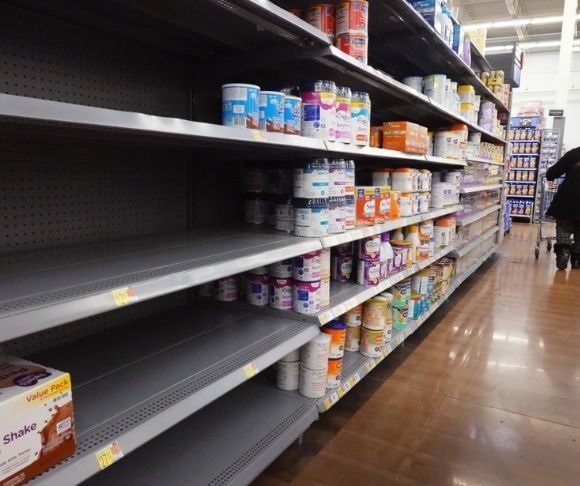
(Photo by Scott Olson/Getty Images)
A baby formula shortage nationwide is intensifying, new analysis from Datasembly shows. Across the country, parents are panicking as 40% of the top-selling infant formula products were not in stock at about 11,000 US stores in the week ending April 24. The report cited a number of reasons for the product’s scarcity: inflation, supply chain shortages, and product recalls.
 Unfortunately, the situation will not dissipate anytime soon, warns Ben Reich, the CEO of Datasembly. “We expect to continue to see the baby formula category being dramatically affected by these conditions,” he said in a statement. “Baby formula stock, which has been one of the more affected categories so far in 2022, and one that will continue to demonstrate higher than average out-of-stock levels.”
Unfortunately, the situation will not dissipate anytime soon, warns Ben Reich, the CEO of Datasembly. “We expect to continue to see the baby formula category being dramatically affected by these conditions,” he said in a statement. “Baby formula stock, which has been one of the more affected categories so far in 2022, and one that will continue to demonstrate higher than average out-of-stock levels.”
States that appear to be the most impacted are Connecticut, Delaware, Montana, New Jersey, Rhode Island, Texas, and Washington. Cities that are enduring concerning out-of-stock rates are San Antonio, Minneapolis, and Des Moines. In addition, prices have not risen in response to the prevalence of out-of-stock stickers on CVS, Walgreens, and Walmart shelves. The costs have only jumped from $24.37 to $26.21 between January and March, representing a 7.5% boost.
This is not the only report to spotlight falling baby formula supplies. Over the last month, the critical product has been gradually dipping, clocking in at 87% in the week ending May 1, according to the IRI CPG Supply Index. Once again, this is another development in the global supply chain crisis that has affected most goods and services across the economic landscape.
Knock on Cathie Wood

Cathie Wood (Photo by Marco Bello/Getty Images)
Investment fund manager Cathie Wood cannot catch a break in the financial markets. During the amazing adventures of the coronavirus bull run after the first wave of the COVID-19 public health crisis, everything Wood touched into gold. Today, everything she touches metastasized into splinters – and it hurts for investors!
Although Wood has attracted investors to her funds, the former Wall Street darling is not convincing everyone. Case in point, ARK Innovation ETF (ARKK), which received $366.7 million on May 3 before cratering 9.5% during the May 5 market rout. Year-to-date, her flagship ETF, which offers exposure to Tesla, Roku, Teladoc, Square, and Coinbase, has crashed more than 50%. The only asset in this fund that has not been obliterated is a money-market cash holding – BNY Mellon’s Dreyfus Government Cash Management Fund – that has risen 0.03% so far this year.
Wood’s track record has been abysmal since peaking early last year. Her losses have been notable, even before this year’s significant drop. The ARK Genomic Revolution ETF (ARKG), ARK Fintech Innovation ETF (ARKF), and ARK Next Generation Internet ETF (ARKW) have plummeted by around 40%. Of course, the writing was on the wall going back to last spring and summer although she insisted throughout 2021 that stocks were not in a bubble. Liberty Nation wrote in March 2021:
“Unlimited quantitative easing, near-zero interest rates, and asset-buying occurring in the United States and around the world can make it challenging for the market to experience a full-blown correction. The bears might need to wait longer for the inevitable popping of the bubblemania in each asset category, from vintage art to cryptocurrencies to real estate. Put simply, as the old market rule dictates, never fight the Fed.”
Quantitative pleasing has transitioned into quantitative tightening. The Everything Bubble is fading. Institutional and retail investors’ sentiment is waning. Inflation is soaring while economic growth is slowing. The only things worth owning in this abnormal economy are a barrel of crude oil, a bar of gold, a pipeline of natural gas, a bucket of coffee, and a neck brace to watch the violent market swings.
From Turkey, With Inflation

President Recep Tayyip Erdogan (Photo by Stephanie Keith/Getty Images)
You know the economy is not good when you say, “Well, at least we’re not Turkey!” Indeed, economic conditions in Ankara are deteriorating as President Recep Tayyip Erdogan believes monetary and fiscal expansion is the only way to stop prices from spiraling out of control.
In April, the annual inflation rate soared to 69.97%, topping the market estimate of 68%. On a month-over-month basis, the consumer price index (CPI) climbed to 7.25%, higher than economists’ expectations of 6%. Producer prices also skyrocketed to kick off the second quarter, exploding 121.82% year-over-year last month. The monthly producer price index (PPI) advanced 7.62%, easing from 9.19% in March.
While the Turkish lira‘s performance has been as horrible as last year, the currency has dropped 12% against the US dollar year-to-date. The nation is experiencing a crisis on every front: inflation, currency, social, and geopolitical. Will the Turkish population survive? The country has been through this before, but the present-day inflationary chaos is prevalent throughout the global economy. There is no escape.
Remember to check out the web’s best conservative news aggregator
Whatfinger.com — the #1 Alternative to the Drudge

